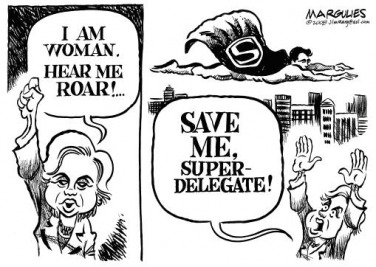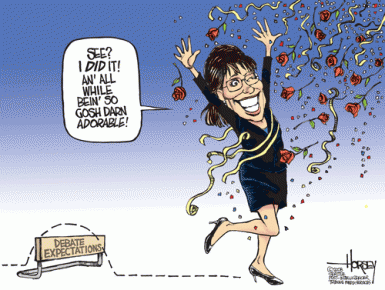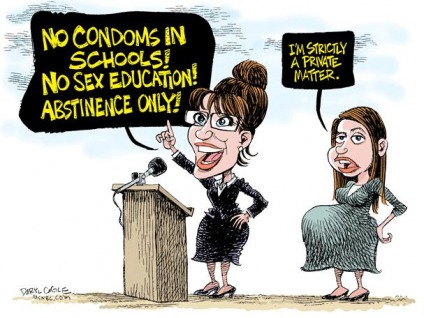MEDIA EFFECT THEORIES
Cultivation- is how repeated viewing of images of political cartoons create certain impressions which influence our behavior, attitudes, and voting decisions.
The cartoon above portrays Hillary first as an extremely powerful and defiant woman who is able to conquer all on her own and then in the second image she is seen as a dependent, needy, emotional and sensitive woman who needs the help of the male super delegate to gain more votes.
Through many political cartoons, Hillary is criticized for all of her characteristics. When Hillary is independent and strong, she is portrayed as mean, too masculine and not nurturing enough. On the other hand, when she is sensitive, emotional and dependent, she is portrayed as being weak, incompetent and unable to lead a country, such as in cartoon number 3 when she was mocked for showing emotion and accused of manipulating the voters of New Hampshire. No matter what characteristic cartoons portray, it is most often construed in a negative light. As stated in the article in the New York Times, “The Feminine Critique” by Lisa Belkin, “Whatever is most valued, women were seen as lacking it.”
Since so many political cartoons portray Hillary negatively, cartoons cultivate a perception of Hillary as incapable in many aspects of serving as president because she is a woman who does not fit the stereotypical mold of a “female.” This repeated criticism may influence the way that people view Hillary because it repeatedly frames her as inferior and less competent to the other male candidates.
Another reason why the negative cultivation may influence voters' attitudes and beliefs is because of the small percentage of women who actually succeed in politics. According to the article "Second-Place Citizens", by Susan Fauldi, “The proportion of female state legislators has been stuck in the low 20 percent range for 15 years; women’s share ofstate elective executive offices has fallen consistently since 2000, and is now under 25 percent (page 2, paragraph 8)."
The repeated images of males dominating politics may influence Americans to develop the attitude that women are more incompetent, especially after viewing political cartoons which frame female candidates as inferior to men. In the previous cartoon Hillary attempts to be confident and powerful but is still also framed as needing the help of the male super delegate.
Framing- The way the media depict the characteristics of political figures, constructing a “reality” by emphasizing certain characteristics while minimizing others.
http://z.about.com/d/politicalhumor/1/0/i/M/2/debate-expectations-tmdho081004.gif
The cartoon above frames Sarah Palin as inexperienced and unable to help lead a nation. Even though she exceeded debate expectations, since they were set so low, it really was not an accomplishment but a disgrace.
The “reality” behind the construction of Palin is that she has spent no time in the Senate and has only been serving as governor of Alaska for a short period of time. Because of the way Palin is framed in this political cartoon and many others, the media tell us how to think by displaying this one characteristic, her lack of experience. When viewing this cartoon, we should take into consideration its reality but we should also be asking ourselves what other characteristics are not being portrayed.
For example, during SNL’s reenactment of the debate between Palin and Biden, we noted in class that they satirized and exaggerated the fact that Palin is very inexperienced. Even though she is far less experienced than Biden, there are still other characteristics outside of the frame that we do not see.
In the cartoon above it portrays Palin as being “Gosh Darn Adorable,” and exceeding the low expectations made before the debate. Because of this cartoon we may be influenced to think that Palin has no experience at all because the public does not expect much from her. As in this cartoon and many others she is frequently framed as ignorant while she attempt to hide her lack of experience behind her beauty and her “girl next door” personality. Although this may be partially true, there is still more to Palin than the cartoons portray. She may not have a lot of experience compared to Biden, but she does have some experience from her time spent as governor.
Selective Perception- is how varying differences of the public’s background, including upbringing, race, gender, socioeconomic status, and life experiences cause them to perceive and interpret political cartoons, which forms their individual opinions.
http://caglepost.com/cartoon/Daryl+Cagle/54862/Palin+Pregnant+Daughter+COLOR.html
People have certain expectations of roles women should play and therefore interpret cartoons based on their upbringing and personal experiences. When viewing Hillary cartoons, a feminist might interpret a cartoon of Hillary being too powerful as being positive because she is taking charge and making a great step for women.
When viewing the above cartoon of Sarah Palin advocating abstinence, the message of the cartoon may be perceived in two different ways, according to the viewer’s background. The intention of the cartoon is to frame Palin as a hypocrite for advocating sex education and abstinence, while her own teenage daughter is pregnant.
A distraught pregnant teenager may see this cartoon and as a result of her own experience, sympathize with Palin’s daughter and view the cartoon in a more personal light because she knows what it feels like to make a mistake. Her background affects her perception because instead of viewing Palin as a hypocrite, she empathizes with the portrayal of Palin’s daughter as the “disappointment” and screw up.
In comparison, if a more liberal viewer was to see the cartoon, he may agree with the way Palin has been framed and it may solidify his beliefs that no matter how much sex education and abstinence are taught, behaviors and patterns of teenage pregnancy will not change. He may take the interpretation of Palin's daughter and develop the opinion that kids will be kids and telling them what to do and preaching abstinence will only make them more likely to explore their bodies and desire to have sex. The interpretation and perception all depend upon past experiences, backgrounds and personal beliefs.
By: Jenna Oldroyd, Courtney Hansen and Natalie Hansen Curtis



